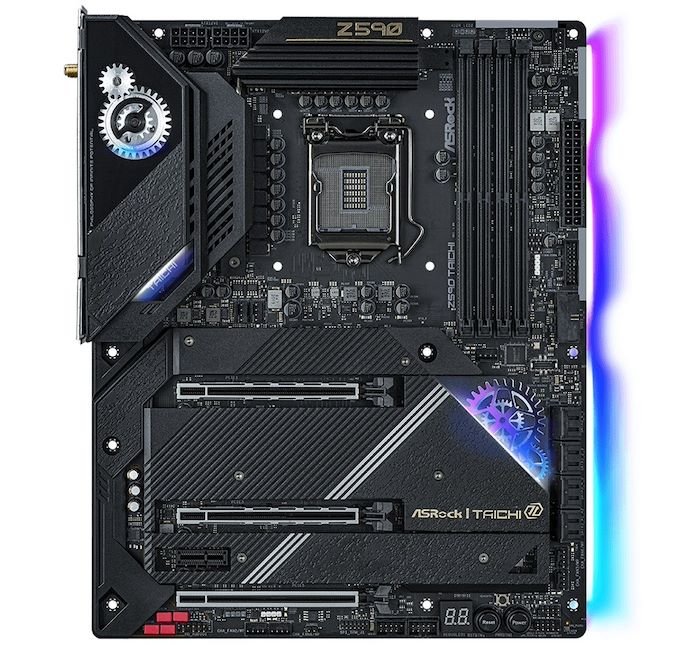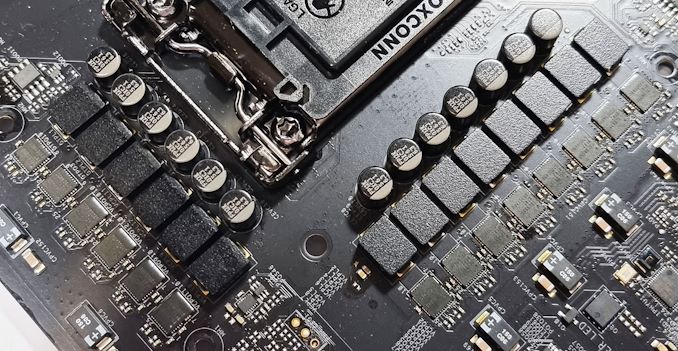Multi-chip Intel Core i9-11900K Overclocking Review: Four Boards, Cryo Cooling
by Gavin Bonshor on August 30, 2021 9:00 AM ESTThe ASRock Z590 Taichi: A Quick Recap
Click here for the full review.
The ASRock Z590 Taichi is the brand's flagship model for Z590, and unless it releases a variant with an Aqua model with custom monoblock, such as it did for Z490 and X570, the Taichi is the main halo. Some of Taichi's prominent features include two full-length PCIe 4.0 slots operating at x16 and x8/x8, with a third full-length slot electronically locked to PCIe 3.0 x4 and one PCIe 3.0 x1 slot. In the top right-hand corner are four memory slots with support for up to DDR4-5000 with a maximum combined capacity of 128 GB.

Looking at storage, the Taichi has a total of three M.2 slots, with one supporting fast PCIe 4.0 x4 NVMe drives and two with support for both PCIe 3.0 x4 and SATA M.2 drives. For conventional drives, ASRock includes a total of eight SATA ports, with six driven by the chipset with support for RAID 0, 1, 5, and 10 arrays; an ASMedia ASM1061 SATA controller powers the other two. Other notable features of the Z590 Taichi include a Thunderbolt 4 controller which adds two Type-C ports on the rear panel, a Realtek ALC1220 HD audio codec and ESS Sabre 9218 DAC pairing for the onboard audio, a Killer E3100G powered 2.5 GbE port, and a Killer AX1675x Wi-Fi 6E CNVi offering support for both the 6 GHz band and BT 5.2.
ASRock Z590 Taichi Key Overclocking Variables
Some of the primary variables to consider which are directly related to overclocking on the ASRock Z590 Taichi include:
- Premium 14-phase power delivery operating at 6+2 (doubled design)
- 2 x 8-pin 12 V ATX CPU power inputs
- Active VRM cooling
- Support for DDR4-5000 out of the box
Delving more into the finer specifications of the Taichi power delivery, it uses a 14-phase power delivery that operates in a 6+2 configuration and is driven by a Renesas ISL69269 PWM controller. The CPU section uses twelve Renesas ISL99390 90 A power stages and is paired up by six Renesas ISL6617A doublers. The SoC section includes two ISL 99390 90 A power stages.

The 14-phase power delivery on the ASRock Z590 Taichi (operating at 6+2)
Keeping the power delivery cool is a pair of heatsinks that are interconnected by a single heat pipe. The overall design includes a small cooling fan which makes this solution an active one, with optional brackets in the accessories for users to install either a 4 cm or 3 cm cooling fan.
ASRock Z590 Taichi Firmware for Overclocking: OC Tweaker
The ASRock Taichi UEFI firmware uses a funky black, blue, and purple accented GUI, which fits in with the board's design. ASRock includes two modes for users within the BIOS, the 'Easy' mode and the 'Advanced' mode. All of the board's overclocking settings and features can be found within the OC Tweaker section of the Advanced area of the firmware.
Inside the OC Tweaker section, ASRock includes individually segmented menus for the CPU Frequency, Memory, and Voltage settings. Being easy to navigate between the three core menus makes it a pleasant experience. When it comes to overclocking on the Taichi, the most common settings for overclocking the processor include the CPU Ratio (frequency), the AVX ratio offsets, and the CPU VCore voltage. On the ASRock Z590 Taichi, applying any custom variable for CPU VCore will force Level 1 of the board's load line calibration settings, although users can change this if they wish to do so.
Other variables to consider when overclocking Rocket Lake on the Z590 Taichi is through memory, with multiple options available to push frequency and tighten or loosen latency timings. The ASRock UEFI firmware is quite aggressive in its interpretation of boost via its Multi-Core Enhancement profiles. However, users can dial these up a notch (or down) with plenty of power settings for alternating Thermal Velocity Boost settings. Users looking to maximize performance on Rocket Lake will need adequate cooling to do so and a capable power supply with enough headroom to cover the increased power consumption that happens when Rocket Lake is pushed.
The ASRock Taichi firmware is a solid example of a BIOS done correctly. However, splitting the primary settings (CPU, Memory, and voltage) into separate menus can be as much of a benefit as a hindrance. There are many settings for users to play around with, but it's recommended that novice users stick to the default settings (we will go into more detail on this in conclusion).
Getting a baseline on stability and maximum all-core frequencies when using the ASRock Z590 Taichi, we achieved the following:
| Achieved Stable Overclock on Each Core i9-11900K | ||
| Intel Core i9-11900K Sample | Achieved All-Core CPU Frequency |
Achieved CPU VCore Voltage (V) |
| Chip #1 - Batch V051F933 | 5.2 GHz | 1.440 V |
| Chip #2 - Batch V051F933 | 5.2 GHz | 1.450 V |
| Chip #3 - Batch V051F933 | 5.2 GHz | 1.460 V |
| Chip #4 - Batch X101J374 | 5.2 GHz | 1.450 V |
Testing our four Core i9-11900K processors with the ASRock Z590 Taichi yielded some interesting results. We managed to hit 5.2 GHz stable with CPU VCore voltages of between 1.440 V and 1.460 V. In terms of silicon quality; we found the best sample with his board to be chip #1, which gave us an all-core overclock of 5.2 GHz at 1.440 V.
In our VRM thermal testing during our full review of the board, we got the following results with the ASRock Z590 Taichi with Chip #1 at 5.1 GHz with 1.450 V:
- VRM Sensor Temp: 68°C
- VRM Probe 1: 70°C
- VRM Probe 2: 71°C
- Ambient Temp: 25°C
The ASRock Z590 Taichi is using an actively cooled power delivery heatsink design, with further room via accessories in the box to add an additional cooling fan. In our testing, we saw very competitive VRM thermals against the other Z590 models we've reviewed so far.












54 Comments
View All Comments
yeeeeman - Tuesday, August 31, 2021 - link
don't wanna be closed in an ecosystemikjadoon - Monday, August 30, 2021 - link
424 W under peak nT overclocked load. Those VRMs were earning their stripes!53W per core. Per core!
Is there a reason besides voltage why Chip #3 significantly beat Chips #1, 2 in POV-Ray + Cinebench R23 nT + GB5 nT on the Z590 HERO ? All were 5.2 GHz. Higher voltage = better clock stability?
//
Is it a typo or a really good deal on the first page chart at the bottom—i9-11900K to be $374, though earlier written as $545.
ceomrman - Monday, August 30, 2021 - link
This is a great article, nice work! The gains are very modest, but more surprising to me was how variable they were. As a consumer buying top-shelf parts, you could easily end up with worse overclocked performance than you'd get at stock settings with a different random CPU and/or expensive, high quality motherboard. Even for uses that would benefit from overclocking, there are very specific configuration choices to navigate. That's not to mention that the kind of tasks that would benefit from absolute max multi-core performance are noticeable faster on a Ryzen or even on older Intel HEDT chips with more cores, anyway. The 11900K is for gaming. Overclocking it yields no gaming improvement. So yeah, don't bother.mode_13h - Monday, August 30, 2021 - link
> using current average US energy prices, assuming the system was at full-load for the> full duration, 10 hours a day over 300 days a year equates to an extra $41 in energy bills.
Please specify what figure you're using for "current average US energy prices". They vary by a lot (in terms of location, time of day (for some), and time of year).
Also, it'd be worth noting that you're not taking into account additional A/C costs. During the winter, some might not need air conditioning, although electric heat is nearly always more expensive that gas or oil (making this an inefficient substitute). However, during the summer, if the A/C is already taxed, the marginal increase in power utilization is probably nonlinear.
Although this sort of matrix testing sheds a little light into variations between boards and CPUs, you should probably use multiple samples of each board to draw any strong inferences about them. More importantly, I think a greater number of readers would be better-served by doing a proper GPU review.
mode_13h - Monday, August 30, 2021 - link
BTW, when estimating energy costs, did you account for PSU losses? If we assume the PSU is 80+ Platinum and running near full-load, it'd amount to another 11% or so.TheinsanegamerN - Monday, August 30, 2021 - link
"The average electricity rate is 13.19 cents per kilowatt hour (kWh)."https://www.electricchoice.com/electricity-prices-...
Dug - Monday, August 30, 2021 - link
"map provides a good representation"Well every site has different averages, so it's misleading.
And most are done by location, not by population. So 100 people paying 9cents and 1 million paying 13cents averages out to 11cents. Which isn't a realistic average.
mode_13h - Tuesday, August 31, 2021 - link
I typically pay about twice that.And if we consider the case of Texas, they typically have lower energy prices. However, during peak-demand season, the spot price really shoots up. During the summer, A/C is so essential that people there will cut back on food expenditures before they completely forego air-conditioning.
Wrs - Monday, August 30, 2021 - link
Or you could back-calculate what kWh rate they were assuming. I suspect a miscalculation somewhere by the quoted… In any case, a TEC is horribly inefficient for substantial active load, and in this case rather ineffective due to being undersized. 200w for 88 C at approx. 300w heat load? Just get a faster water pump to beat that with ambient liquid cooling. Electric cost would be pennies on the dollar!thestryker - Monday, August 30, 2021 - link
It sure seems like some sort of adaptive core overclocking would be key on these processors. On my 6800k, and now 6900k, I definitely have my overclock set for 2 and all cores just to keep the voltage down, but gain extra clockspeed for lightly threaded. It's not perfect, but assuming this type of setup works on z590 properly it would at the very least keep that stock boost if not allow for higher.In general from what I've read regarding both AMD and Intel's recent processors though it just seems like overclocking for a daily driver just isn't particularly worth it. Maybe with the upcoming ADL there'll be something extra to squeeze out of the E cores, but otherwise the future sure seems like minimal OC gains.